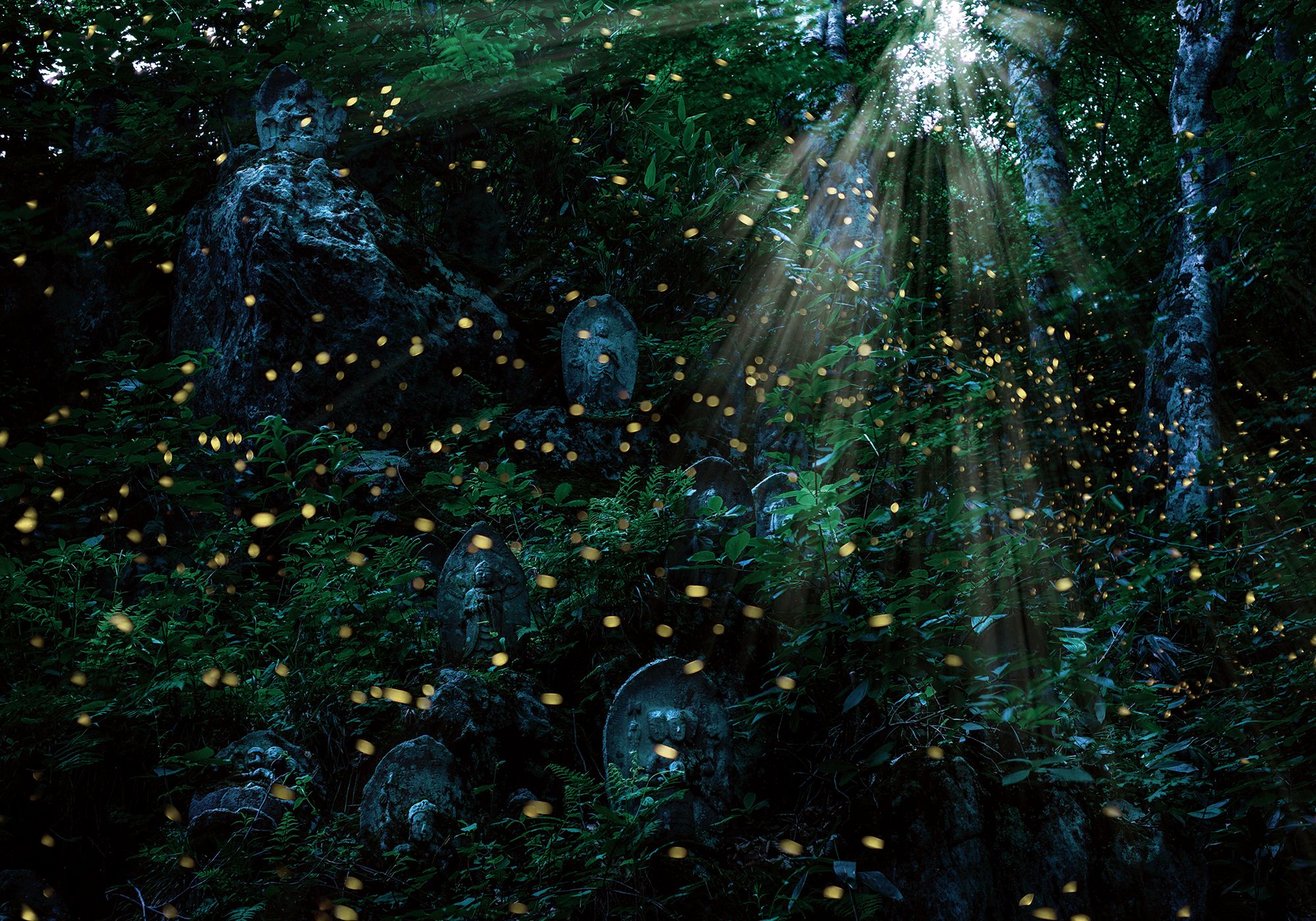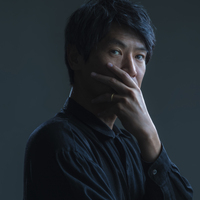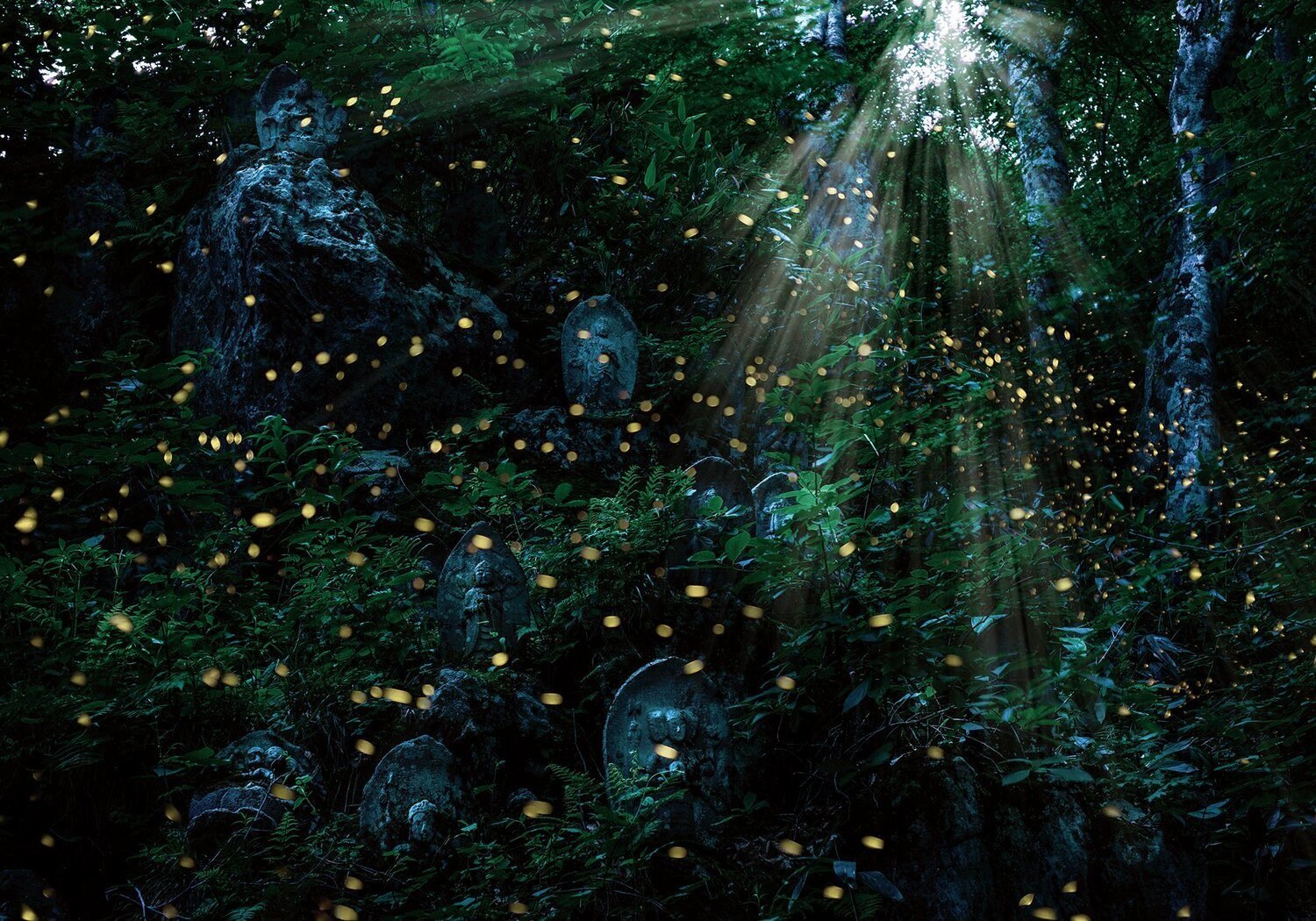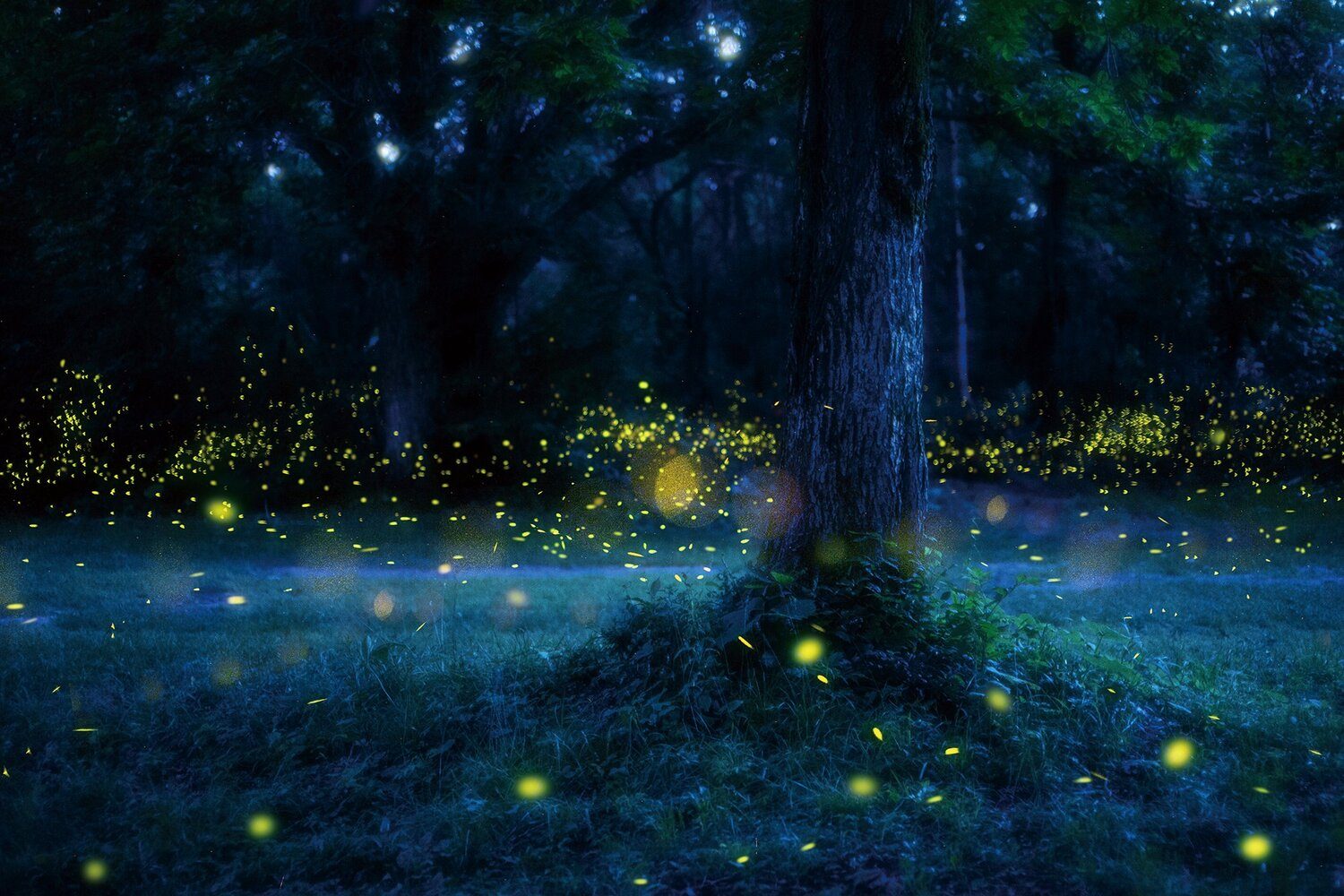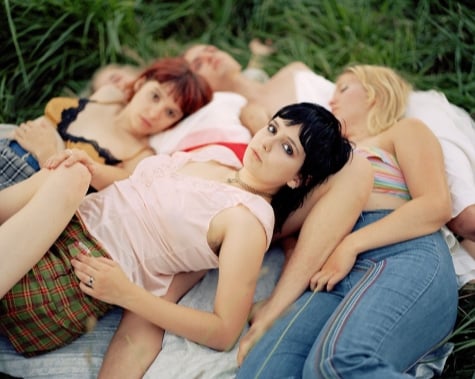Confronting the darkest depths of the nocturnal forest, Kazuaki Koseki experienced an awe-inspiring image that he just couldn’t shake. As if painted with light, the forest transformed, enchanted by the twinkling flight paths of the ‘himebotaru,’ a firefly endemic to Japan. For eight years, he has returned to the forest of the Yamagata prefecture in the Tōhoku region during the summer to observe the ecology of the species and try to translate what he first saw into photographs.
Summer Fairies is an offering born of devotion and hard-earned skill that seeks to share the beauty of the firefly with the world. Faced with increasing threats caused by human activity and climate change, the firefly is one of many living things at risk in these unstable times. Koseki’s records of these quiet and sublime nocturnal happenings are charged with a deep love for his luminous “neighbors,” speaking to his “happiness of living in a world that is irreplaceable.”
In this interview for LensCulture, Koseki speaks to Sophie Wright about his connection to his immediate surroundings, the varied landscapes of the Tōhoku region and the evolution of Summer Fairies.

Sophie Wright: Photography is in your DNA as your family ran a photo studio, which you are now in charge of. I’m curious about how you found your own photographic voice out in the wilderness.
Kazuaki Koseki: My earliest memories are from childhood with my family of time spent in nature. My father and mother often took me out into nature—fishing, climbing mountains and spending time at barbecues. Then, in my mid-twenties, I discovered fly-fishing, which originated in the UK and involves fishing with a hair trigger. I started fishing in rivers close by and gradually began to spend most of my holidays in nature, walking through forests and up mountains, walking in mountain streams and fishing for trout. The seasonal scenes of rivers, forests and nature, which only anglers can see, and the time spent there, are very beautiful.
Fly fishing is a very difficult way to catch trout, using a hair hook to trick them, and I needed to know a lot of things in order to be able to catch trout at will. I learnt not only about the ecology of trout, but also about the seasonal changes in the river, the aquatic insects that trout feed on, the geology that forms the river, the weather and much more, through fieldwork in nature and from books. It was like a journey into the natural order of things. I continue to walk in nature with my camera, listen to the sounds of nature, see it, touch it, smell the seasons, eat its bounty from time to time, and feel it with all five senses.
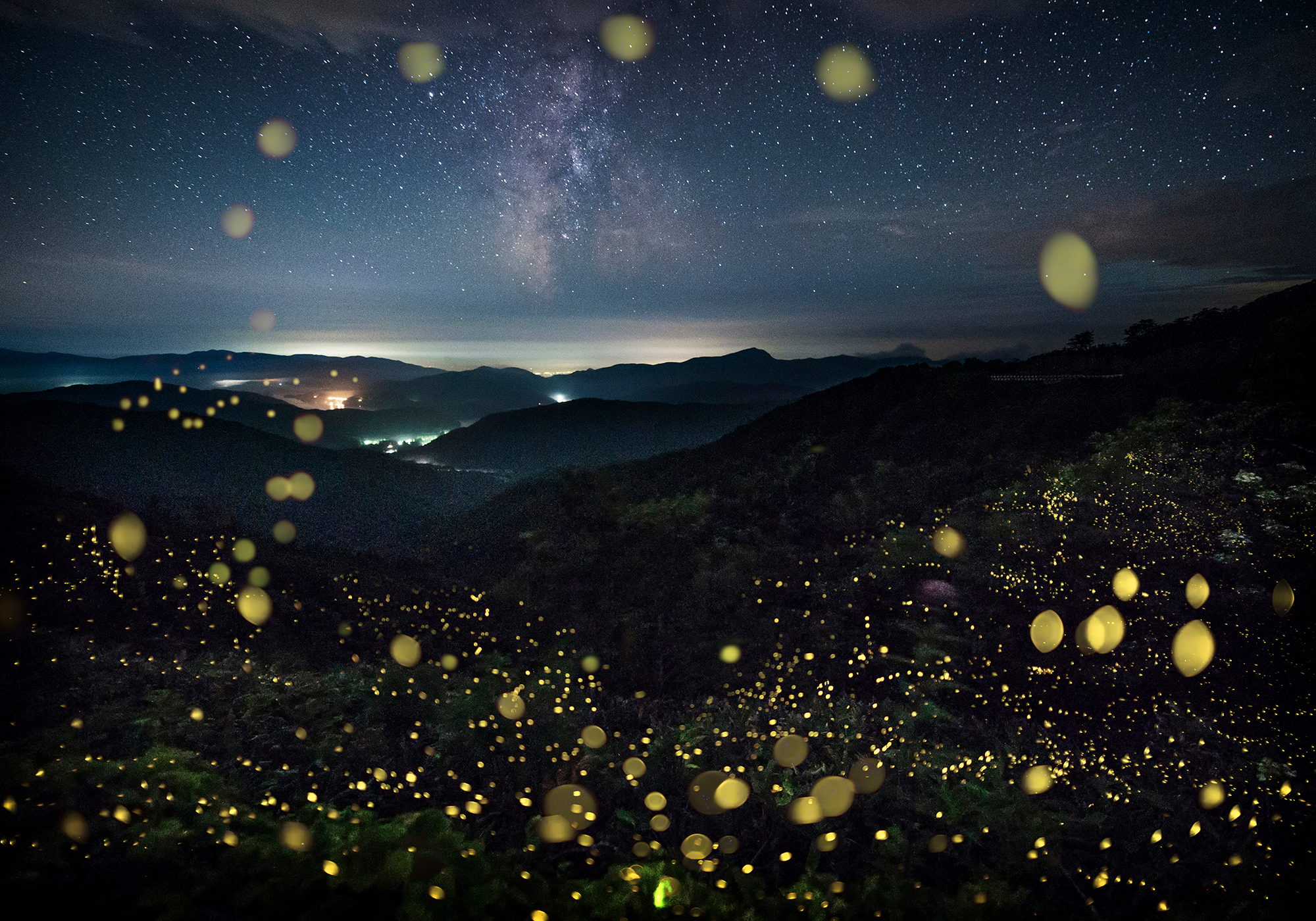
SW: Can you describe the surroundings of Yamagata and Tōhoku that you explore in your work? And how do they inspire you?
KK: Japan is not a large country, but it has four distinct seasons. The Tōhoku region is rich in nature, with much of its wilderness intact, as well as many ancient beliefs and unique cultures. The Ou Mountains lie in the center of the Tōhoku region, and the climate differs slightly between the east and west of the region on the border of the mountains. Yamagata, located to the west of the Ou Mountains, is where I was born and have lived since. It is a land surrounded by mountains, where the four seasons change markedly, with several meters of snow in winter in some places and hot and humid summers in others. It is a land where the ancient Jomon people lived, and nature worship, especially mountain worship, flourished.
Spending my days out in nature and the climate, spiritual features of Tōhoku and Yamagata and their changing seasons—changes that I experience with all my senses—brings me a lot of inspiration. On 11 March 2011, the Great East Japan Earthquake struck the east coast of Tohoku, including Miyagi Prefecture, where I lived when I was younger. Seeing my friends die and so many others affected, I learnt about the ferocity of nature and the fragility of life. Then, the Fukushima Daiichi nuclear power plant accident engulfed the Tōhoku region in an invisible terror. It also enveloped the river I used to travel on for some time. These experiences were a very big driving force for me to start creating my artwork.
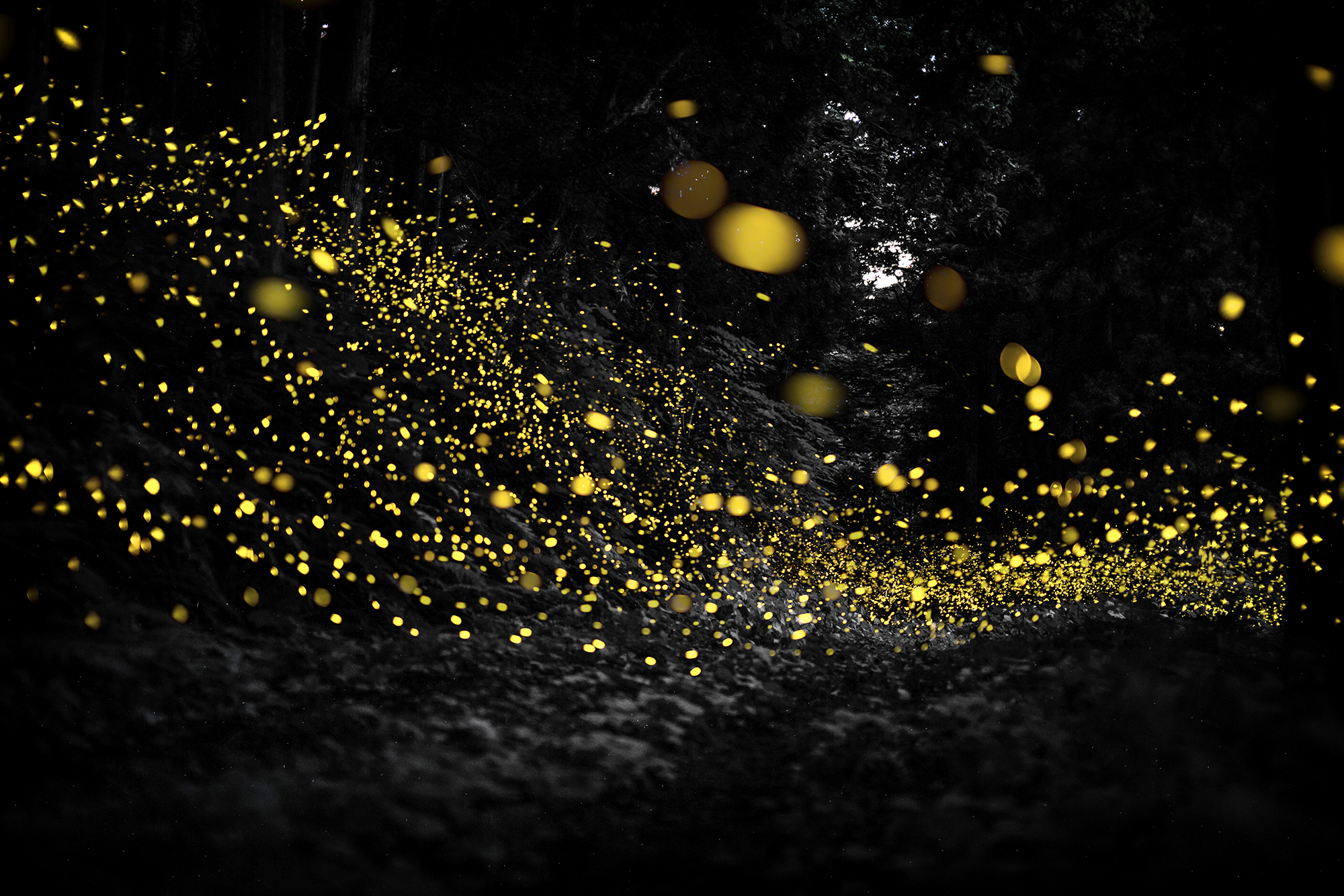
SW: Each of your projects seem to tune you into the different rhythms and seasons of whichever element of nature’s cycles you have chosen to focus on. Do you see photography as a tool that connects you to the world around you? What motivates your impulse to document your chosen subjects so carefully?
KK: Nature cannot speak like people, but if you spend a lot of time in it, sometimes it seems to speak to you and tell you something—in a very quiet voice. I take pictures of these events with my camera and, sometimes, you can hear it in the pictures you take. Nature is sometimes beautiful, majestic, threatening and fragile. Nature is like a living organism, of which we are a part.
Photography is like a dialogue with the subject or phenomenon for me. I want to understand nature deeply by feeling it with all my senses. And by recording it, I want to feel the ‘now’ of living on this planet. Perhaps it is to confirm the happiness that I am living in a world that is irreplaceable.

SW: Tell me about the first night you encountered a firefly. What was it about them that caught your attention and turned this into an eight-year-long project?
KK: When I first learned of the existence of these ‘Himebotaru,’ (fireflies), I wondered if they existed in the nature of Yamagata as I knew it. I opened a detailed mountain map and researched the forests that might be inhabited by these creatures. When I found a spot, I drove my car deep into the forest to the end of the road and started walking alone into the forest at night without moonlight. The uninhabited forest at night is the territory of beasts, and although I felt a strong fear, I walked deeper and deeper. After about 30 minutes, I found a small yellow light that seemed to twinkle, and when I switched off the light, I saw countless small lights twinkling in the forest.
After a while, my eyes became accustomed to the darkness and the silhouettes of the forest began to faintly appear as the countless lights glowed. It was like a starry sky. The darkness of the forest, which was terrifying, continued to spread out before my eyes as the most beautiful forest I had ever seen, thanks to the countless twinkling lights. When I returned home that night, even after some time had passed, the sight lingered in my mind. It was an emotional experience.
What kind of image did the light I saw in the darkness—that I was afraid of—give to my brain? This dialogue in myself continues to this day. And so I began the project to explore nature, ecology and various phenomena, including the forests in which the firefly lives, and confront the fireflies over a long period of time. Perhaps a lifetime.
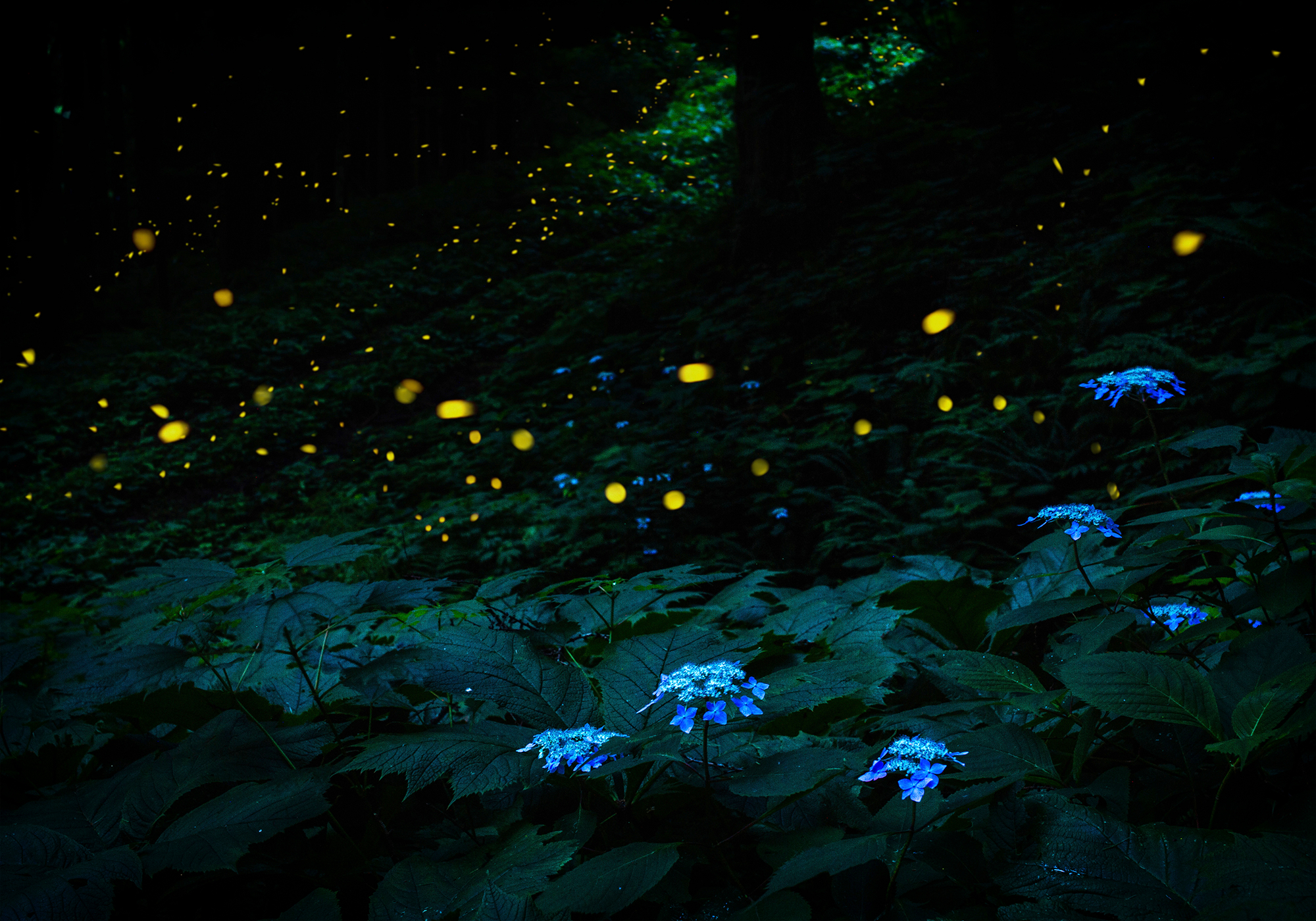
SW: Can you elaborate on the species itself and the habitat they live in?
KK: There are many different firefly species in Japan, the most common of which are the water-dwelling ‘Genji-botaru’ and ‘Heike-botaru’, and the forest-dwelling ‘Hime-botaru (Luciola parvula).’ The firefly I photograph in this series is the ‘flamefly;’ a small species about 7mm long with a low light intensity and an issue interval of about 0.5 seconds. Similar species can be found in Asia and Europe, but the ‘himebotaru’ is endemic to Japan. Because it lives in forests, much of its habitat has remained unknown until recently, and its ecology and other aspects remain unexplored.
I have observed them in forests in several areas of Yamagata Prefecture, but it is not easy to expand their distribution area because the female ‘himebotaru’ has degenerated hind wings and cannot fly. Through repeated observation and exploration, I have surmised that fireflies have traveled for a very long time from areas south of Japan, or perhaps even from more southerly countries. I am searching for the paths (forests) that the ‘himebotaru’ have followed and discovering new habitat areas. These forests, some of which are primary (old-growth) forests—but also include planted forests, orchards and other forests that have been associated with people—mean that the environment in which fireflies have been able to survive for a long time remains.
SW: What significance does the firefly have in Japanese culture?
KK: Few people in Japan are unaware of the existence of fireflies. Fireflies have long been the subject of many songs, poems, stories, picture books and even animations. Even those who have never seen fireflies in person can picture them as an original landscape and a poetic feature of pre-modern, old Japan.
The word ‘firefly’ was first mentioned in Japan 1,300 years ago in the Nihon Shoki, the oldest book in Japan. It was described as ‘(螢火)Hotaru – Fire’. As they glow in the dark, fireflies are often thought of as fire or stars. Since ancient times, Japanese people have associated the fireflies shining in the dark night with the souls of human beings and the souls of the dead.
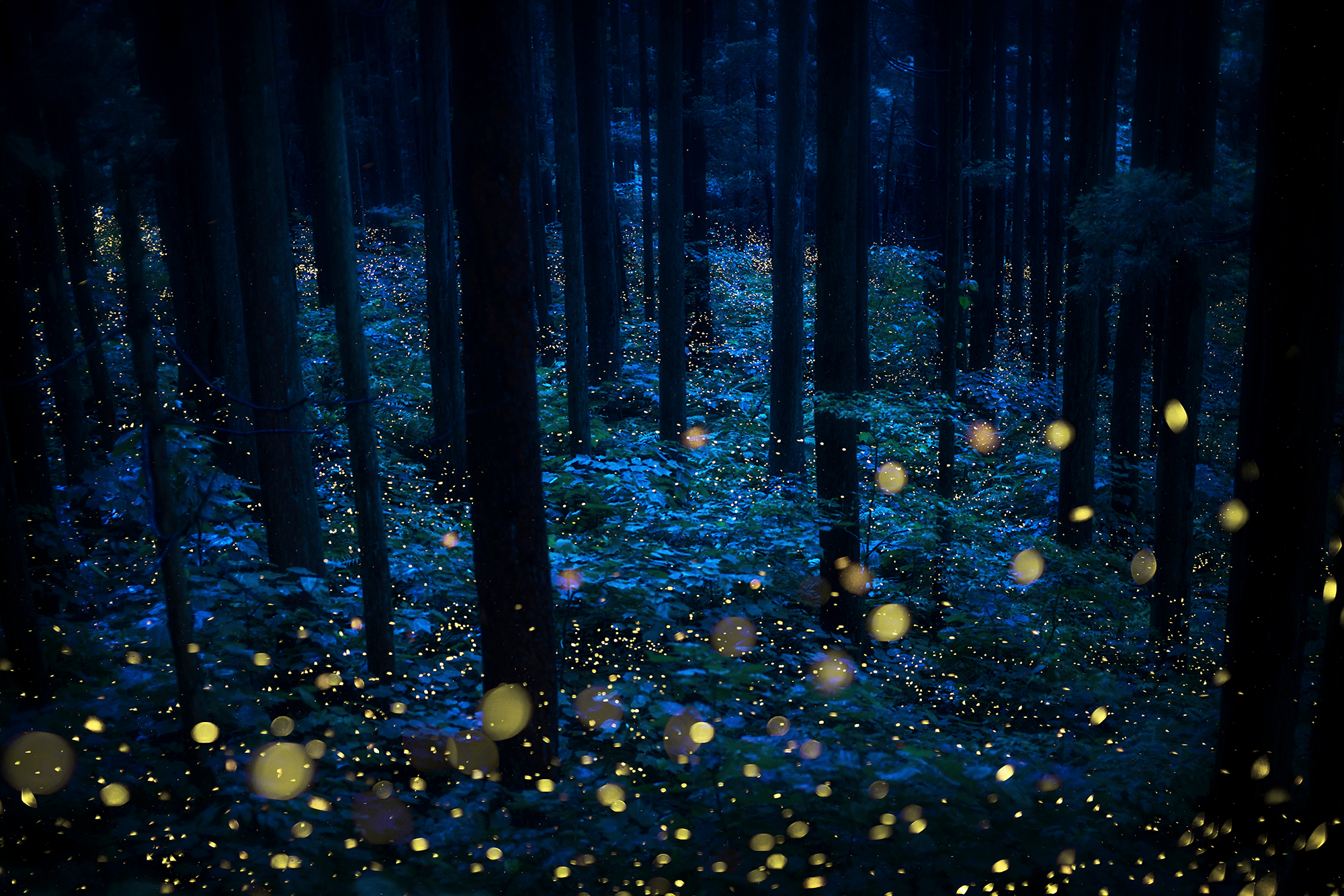
SW: Your images manage to render visible a near-ethereal, brief natural event. Can you tell me about your shooting process and the aesthetic of the project?
KK: This series of works was shot using long exposures. The length of each shutter speed ranges from 10 seconds to five minutes. The forest is observed, composed and the camera is set up on a tripod before the sun has set. This process of composition sometimes takes a long time, and some compositions have taken several years to achieve. It is important to me to imagine the forest in the dark and express its essence and beauty, as the way the forest looks (or appears) changes dramatically when it is dark.
There is a density to the darkness that is affected by the moonlight, the slight light from distant city lights reflected in the sky and clouds—and even the amount of white clouds and starlight—and changes with the time of day. The forest is illuminated by these very small amounts of light.
Another key element is to predict which altitude and route fireflies prefer to fly and to capture the parabolic lines they draw. The unpredictable light trails of the firefly are determined by a variety of factors, including the density of darkness in the forest, the terrain and the vegetation. In photographing using long exposures, the final image is obtained by the light drawn irregularly by the fireflies. The ‘himebotaru’ is also an artist who paints the forest with light. This is a dialogue and exploration between me, the forest and the fireflies, which continues every night for about three weeks in early summer.
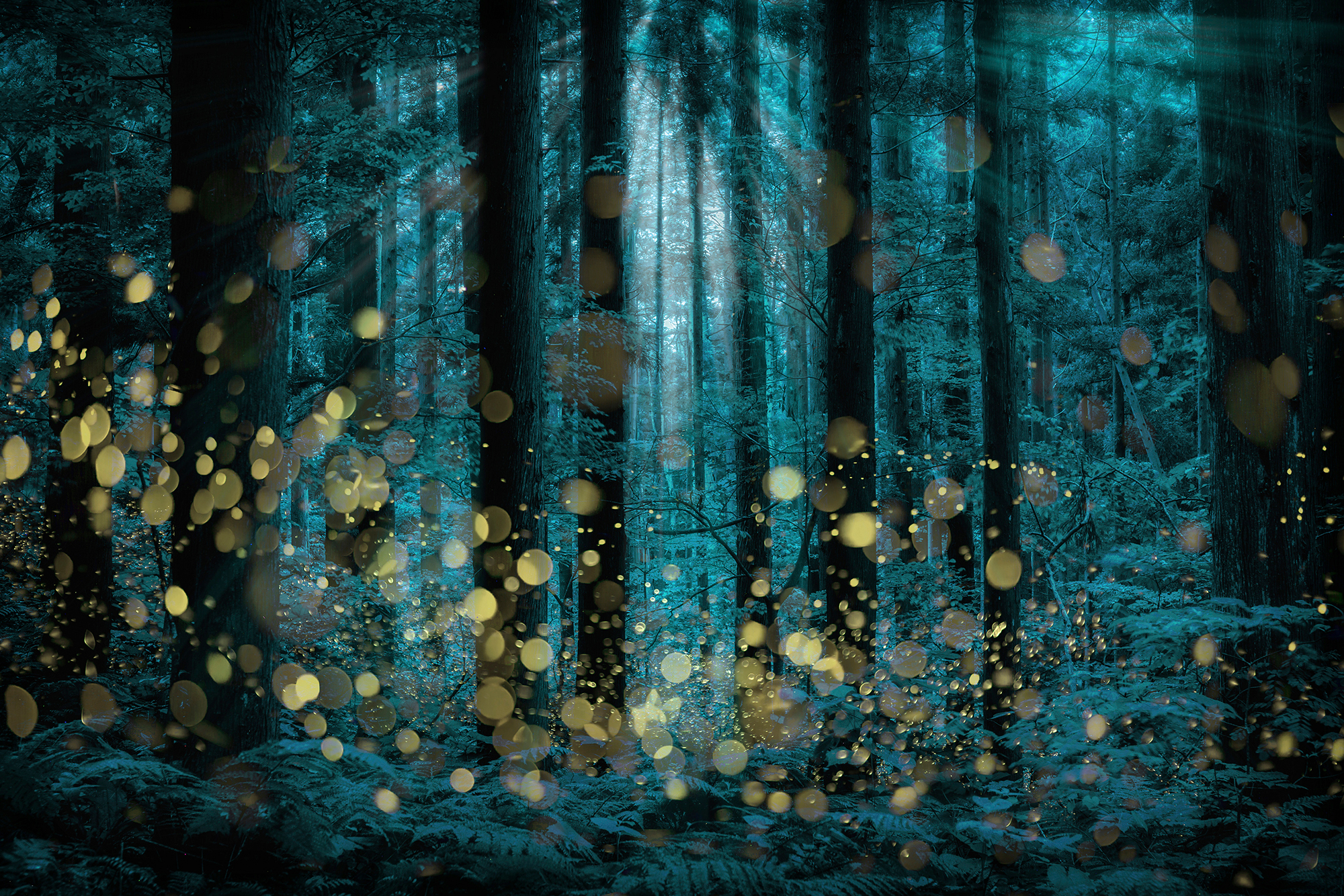
SW: Has this process changed at all over the course of the seven years you’ve been shooting?
KK: This dialogue has accumulated over the years and the series has evolved, adding time, the history of fireflies, the region and the forest, human interaction and unpredictable light trails. In the early years, the most important thing was to show the entire time—represented by light—during which fireflies fly during one night, which ranges between one and a half to two hours. In the medium term, the overlapping of time was expressed by multiple exposures at the same location. Currently, the emphasis is on depicting the diversity and unpredictability of the firefly’s light trails in a shorter period of time.
SW: Is this the first project that you’ve made that focuses on a specific being (as opposed to an environment that contains many different elements)? What kind of challenges did you encounter in this shift?
KK: Perhaps the biggest challenge of this series was to find and encounter fireflies where they live, and luckily I was able to do just that. I had previously worked on a project called Forest of Misty Vision, which focused on the ‘submerged forests’ that appear in early spring, but the major challenges of Summer Fairies were the limited seasonal duration of the forest in early summer, and the low light intensity at night, which makes the variations of light easily monotonous. However, during the eight years of work, I discovered and added several elements which were gradually resolved and the series became more expansive. For the protection of fireflies, no deliberate artificial lighting has been used.
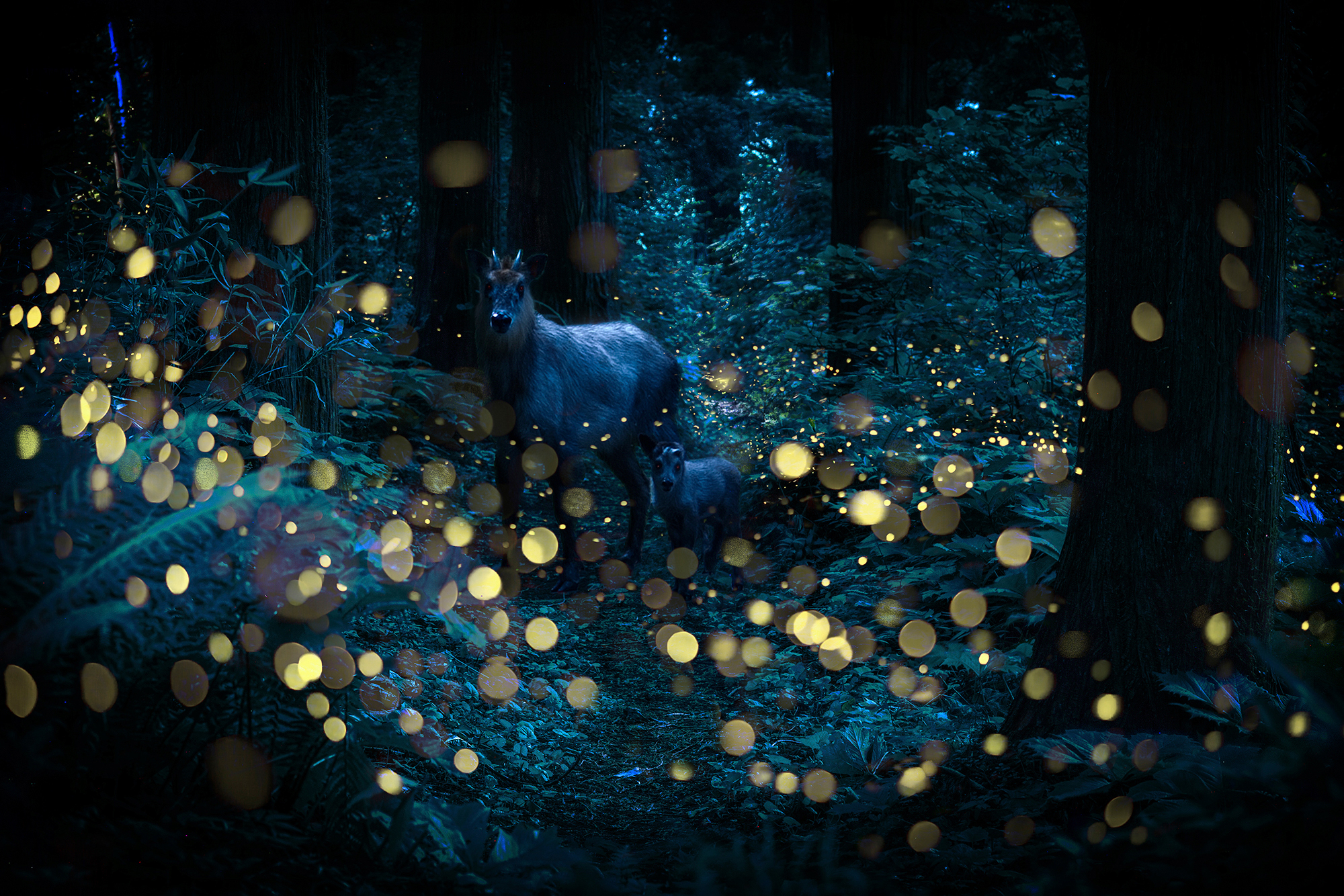
SW: Like many beings living in our world today, the himebotaru are vanishing. Can you elaborate on the threats the firefly faces?
KK: They have lived in uninhabited, deep forests for a long time. Especially in the last 100 years or so of modernisation, a lot of these forests have been cut down for various reasons—-to create farmland, pastures, roads, places for people to live, tourism developments, etc—leaving no place for them to live unaffected by human activity. The fireflies we see today are those that have escaped such threats.
There are also concerns that the torrential rains and wildfires caused by climate change in recent years could damage firefly forests. And with the development of solar and wind power, which is being promoted for environmental protection, forests are also being cut down. They live under constant threat of our modern times.
In recent years, temperatures have been on the rise and Yamagata has been experiencing an increasing number of years with very little snow. In years with less snow, fireflies are more active and fly around more, probably because less snow means they can stay active longer and survive by feeding on more prey. Although they naturally prefer warmer climates, they live in harsh, snowy terrain. If the forest environment continues to exist, they may survive more robustly than expected, adapt to the present-day Earth and thrive far longer than we humans have.
SW: Do you believe photography can play a role in protecting our environment?
KK: I still don’t know what role photography can play now. But if it can play a role, if it can create a sense of reverence for nature in people’s hearts, then it will give meaning to my photography and exist as our ‘group ego.’ The forests I go to are also the nature that people can reach in my local area. It is my hope to remind everyone that we have many neighbors living around us all the time, all coexisting together on this planet called Earth.

